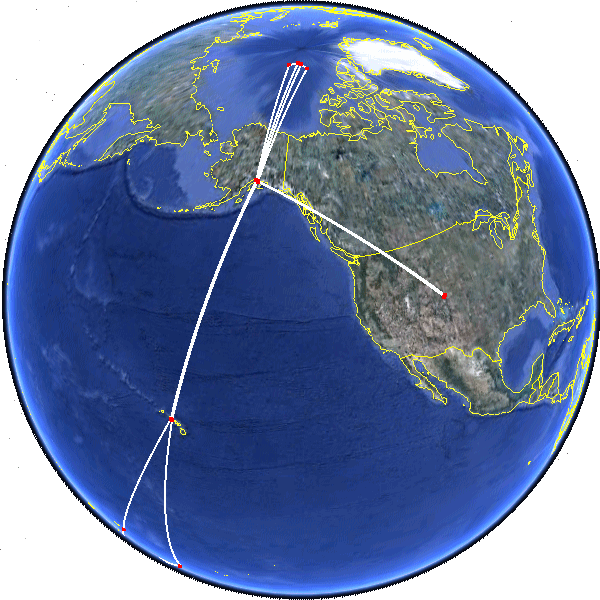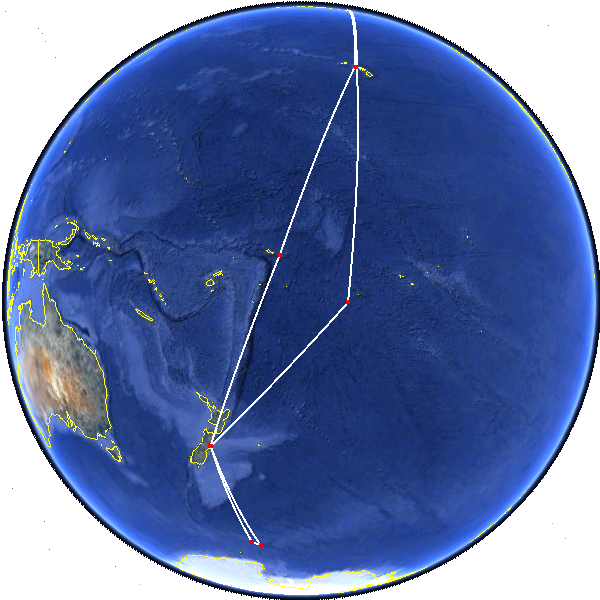HIPPO 5
HIAPER Pole to Pole Observations 5 (HIPPO-5)
The "Collaborative Research: HIAPER Pole-to-Pole Observations (HIPPO) of Carbon Cycle and Greenhouse Gases Study" measured cross sections of atmospheric concentrations approximately pole-to-pole, from the surface to the tropopause, five times during different seasons over a three year period. A comprehensive suite of atmospheric trace gases pertinent to understanding the Carbon Cycle was measured. HIPPO missions transected the mid-Pacific ocean and returned either over the Eastern Pacific, or over the Western Atlantic. The program provided the first comprehensive, global survey of atmospheric trace gases, covering the full troposphere in all seasons and multiple years. This phase of the HIPPO project was the fifth and last one of five, taking place in September 2011. HIPPO Global Phase I took place in January 2009; Phase II in November 2009 and Phase III in April 2010. Phase IV took place in June 2011.
To accomplish the objectives of the fifth phase, the NCAR G-V flew the following missions:
- Rocky Mountain Metropolitan Airport, CO, USA -> Anchorage, AK, USA
- Anchorage, AK to the North Pole (up to 85 degrees North) round trip
- Anchorage, AK, USA -> Kona, Hawaii, USA
- Kona, HI, USA -> Pago-Pago, Am. Samoa or Rarotonga, Cook Islands (as a backup)
- Pago-Pago, Am. Samoa -> Christchurch, NZ
- Christchurch, NZ -> South Pole (up to 67 degrees South)
- Christchurch, NZ -> Pago-Pago, Am. Samoa
- Pago-Pago, Am. Samoa -> Kona, Hawaii, USA
- Kona, Hawaii, USA -> Anchorage, AK, USA
- Anchorage, AK to the North Pole (up to 85 degrees North) round trip
- Anchorage, AK, USA -> Jeffco, Colorado
This 48,000 km route is the same as the Phase 3 route. Phase 2 route went over the Western Central Pacific. Phase 1 was flown south over the Central Pacific and returned over the Eastern Pacific, and Phase 4 covers the Western Pacific. The specific goal of Phase 5 was to repeat the sampling of the productive regions of the Eastern Pacific, in addition to the major goal of HIPPO that was to monitor seasonal changes of greenhouse gases in the atmosphere.
All of the flights were essentially direct point-to-point routes with ongoing altitude changes. It was planned to have two maximum altitude ascents per flight, one in the first half and one in the second half, depending on the ability of the ATC to support altitude changes. Most of the flight was be conducted below RVSM (usually 28,000 ft) in order to allow the G-V to go up and down constantly to collect data at different altitudes throughout the troposphere. Ideally the flight would take off and go to FL430 for 15 min, then descend below RVSM and proceed in a sawtooth pattern between FL270 and FL100 with a 1,500 ft/min climb/ascent rate, then climb to FL450 near the end of the flight for about 15 min, descend and proceed to the airport.
All flights were followed by at least one no-flight, maintenance day and may be followed by a rest day ("hard down" day); see the work schedule for details.
Principal Investigator:
Steve Wofsy Harvard/SEAS
swofsy AT seas.harvard.edu
Project Manager:
Pavel Romashkin NCAR/EOL/RAF
pavel AT ucar.edu
EOL Data Management:
NCAR/EOL/DMS
eol-archive AT ucar.edu
CDIAC Data Management:
Les Hook CDIAC/ORNL
hookla AT ornl.gov

